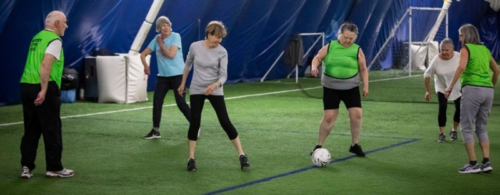Sport for Life applauds physical activity opportunities for older adults

Sport for Life’s multistage Long-Term Development in Sport and Physical Activity framework is not only for athletes: it also describes developmental periods for individuals as they participate in sport and physical activity throughout their lifetime.
When it comes to sport opportunities, there’s no reason why seniors need to stay on the sidelines.
Recently the North Shore Girls Soccer Club decided to introduce a free program for seniors, a move that drew the attention of CBC Vancouver. Called “Walking Soccer”, it’s a low-impact version of the game for people who are 60-plus and looking to get active.
“After we saw so many smiling seniors on the sidelines, we wanted to offer a program in our club that’s good for everybody,” said executive director Jana Madill.
This is exactly the type of initiative envisioned by Sport for Life resources such as Durable by Design: Active for Life. Research shows that in spite of the clear evidence demonstrating numerous benefits associated with regular exercise, particularly for mature adults, only 15% of Canadian adults meet national physical activity recommendations and rates of sport participation have declined in the past several decades among Canada’s growing population of older adults.
Walking soccer is also being offered in South Surrey by Sport for Life project partner Coastal FC as a way to diversify their membership and get older adults engaged in activity.
Being active long-term
Large segments of society — including public institutions — still tend to view physical activity and sport as the domain of children, teens, and professional athletes. Too many Canadians face significant barriers to engagement in regular exercise or do not fully appreciate the life-changing benefits that can be derived from continued participation in physical activity and recreational sport.
What if this could be changed?
According to Durable by Design, maintaining physical literacy can be a key to preventing or mitigating some of the challenges associated with aging. By helping every Canadian develop fundamental movement skills from a young age, our population can acquire and maintain the confidence to move throughout their lives. This will encourage higher rates of participation and generate a broad range of health benefits for Canadians of all ages and abilities.

Quick facts
After people reach the age of 65, their functional health begins to decline at a faster rate. As a larger proportion of Canadians are living into their 70s and 80s, this means that the average Canadian can presently expect to live approximately 10.5 years with some level of lower ability.
In your seventies, and for some their eighties, nineties and beyond, regular physical activity is vital in managing physical, cognitive, and emotional well-being. It is important to combat age-related physical declines through targeted exercises, including balance and strength training. Individuals who maintain a moderate to high daily level of activity are less likely to be taking multiple medications, seriously injure themselves from an accident, or develop dementia.
Through targeted exercise and activity, adults with chronic conditions can potentially improve their sleep, lower their BMI, improve their blood sugar control, and deal better with stress and anxiety.
Relevant Resources
For those who are interested in becoming physically active, the following resources will give you contextual information about the benefits of physical activity as well as strategies on how to develop your physical literacy over your lifespan.
- Developing Physical Literacy – Building a New Normal for all Canadians
- Active for Life: Durable by Design
- Long-Term Development in Sport and Physical Activity 3.0

